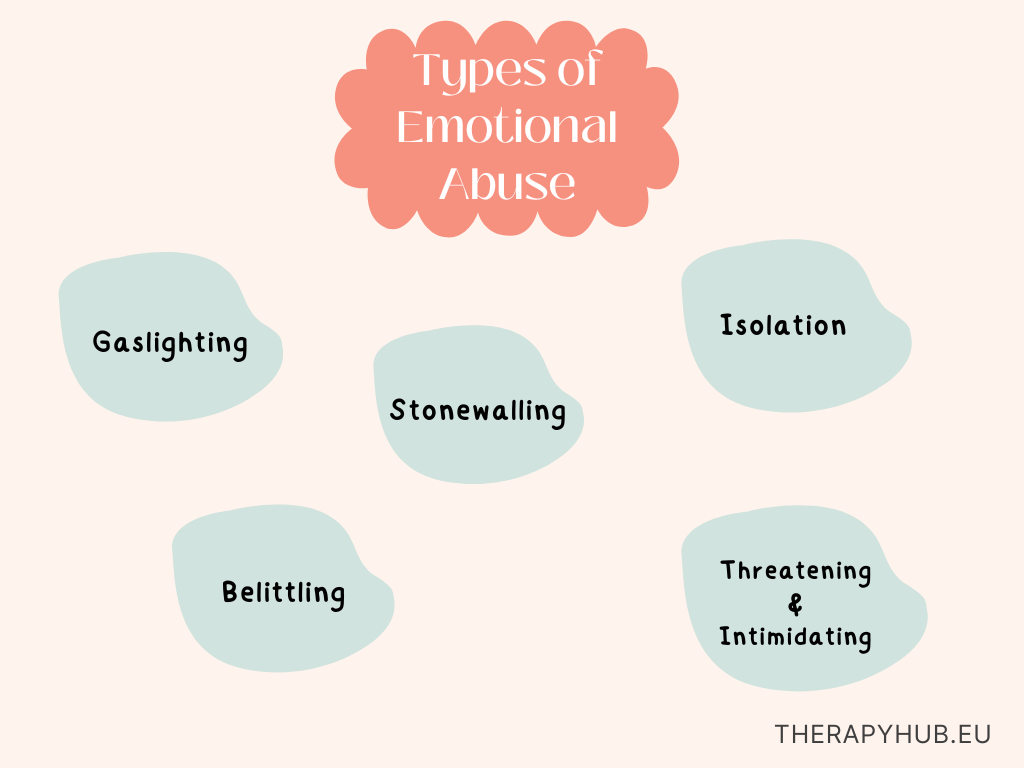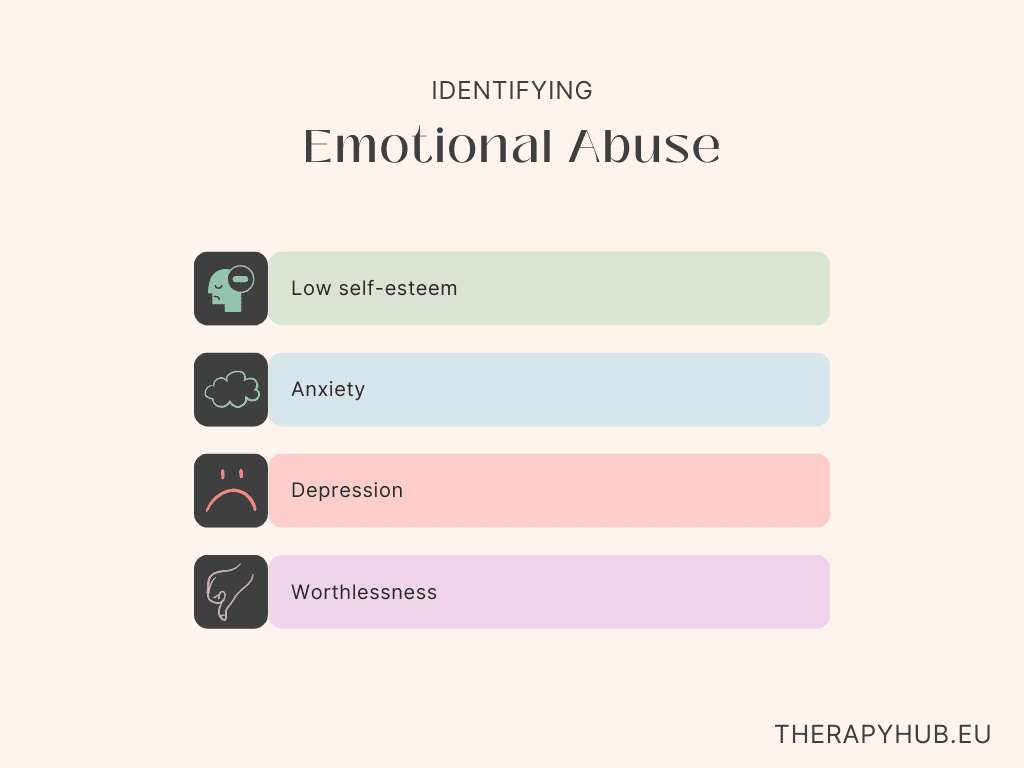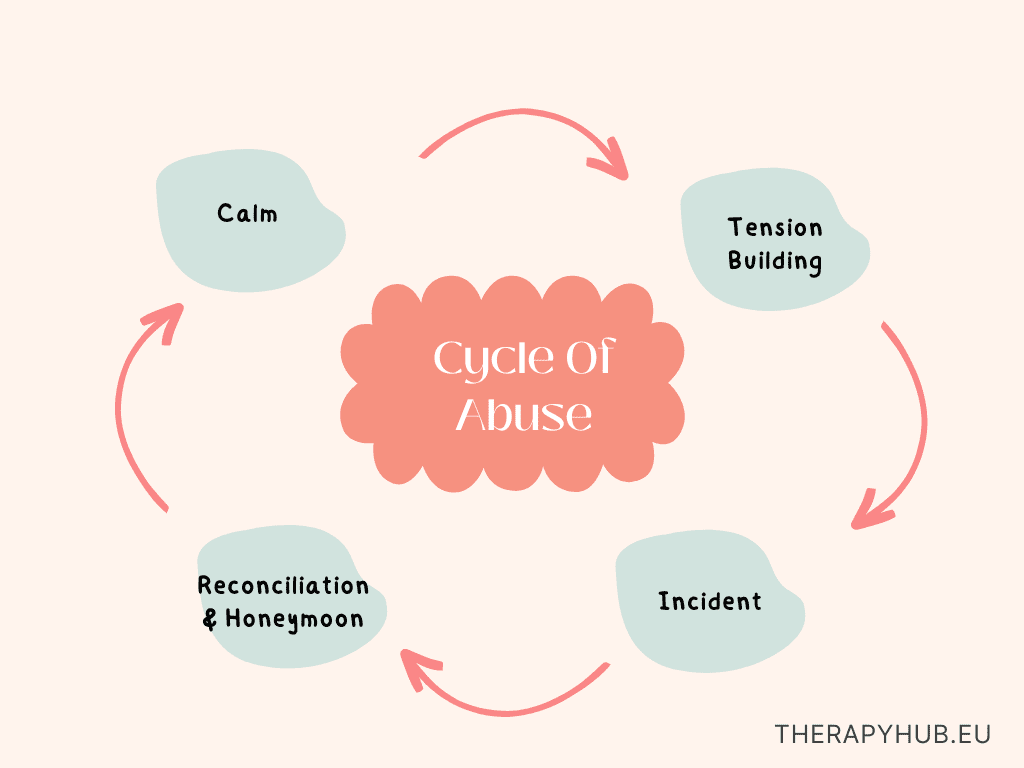
Emotional abuse is a type of abuse that can take place in any environment – at home, school, or work. It is important to understand that emotional abuse is not limited to romantic relationships or parent-child relationships, but can also occur between friends or colleagues. Despite being difficult to recognise, it can leave deep emotional scars that can have a lasting impact on an individual’s mental health.
Emotional abuse can take many forms, including but not limited to verbal attacks, manipulation, and isolation from friends and family. Often the language used to describe the person undertaking the abuse is to call them an abuser, and that the person on the receiving end of this is the victim. I’ll use that language here, though I understand their meanings can feel challenging for some.
An abuser might make derogatory remarks about the victim’s appearance, abilities, or intelligence, or deliberately withhold affection or support as a means of control. It is important to note that emotional abuse can be just as damaging as physical abuse, and in some cases, even more so, as it can go unnoticed and is typically not taken as seriously.
Moreover, emotional abuse can also manifest as gaslighting, which is a form of psychological manipulation that aims to sow seeds of doubt in the victim’s mind, making them question their memory, perception, or sanity.
This can lead to feelings of confusion, self-doubt, and a loss of confidence, and can be particularly harmful when the victim is already vulnerable or dealing with other stressors in their life.
It is crucial to recognise the signs of emotional abuse and to seek help if you suspect that you or someone you know is a victim. While it may not leave visible bruises or scars, emotional abuse can have a profound impact on an individual’s well-being and should be taken just as seriously as physical abuse.
Types of Emotional Abuse
Emotional abuse can take many forms. Here are some of the different forms of emotional abuse that occur.

Gaslighting
Gaslighting is a form of emotional abuse that can have devastating effects on the victim’s mental health. It is a tactic used by abusers to gain power and control over their victims by making them doubt their own perceptions of reality. The term “gaslighting” comes from the 1944 film “Gaslight,” in which a married woman is convinced by her partner that she is going insane by dimming the gas lights in their house, and denying that he has done so.
Gaslighting can take many forms, but it often involves the abuser manipulating the victim’s thoughts and feelings to make them question their sanity. This can include denying that certain events have occurred, trivializing the victim’s feelings and experiences, or creating situations that are designed to make the victim doubt themselves.
One of the most insidious aspects of gaslighting is that it can be very difficult to recognise, especially in the early stages. The abuser may start by making seemingly innocent comments or questioning the victim’s memory, making it hard for the victim to know whether they are overreacting or not. Over time, the abuser may escalate their tactics, making it increasingly difficult for the victim to trust their own perceptions and causing them to doubt their own sanity.
Gaslighting can have a range of negative effects on the victim’s mental health, including anxiety, depression, and post-traumatic stress disorder. Victims of gaslighting may feel like they are going crazy, and may experience a sense of confusion, self-doubt, and a loss of confidence. They may begin to second-guess their own thoughts and feelings, and may have trouble trusting their own instincts.
Belittling
Belittling is an insidious form of emotional abuse that can be particularly damaging to a victim’s self-esteem and mental health. It involves the abuser insulting or mocking the victim, making them feel small, worthless, or unimportant.
Belittling can take many forms, including criticism of the victim’s appearance, intelligence, or abilities. For example, an abuser may tell their victim that they are stupid, ugly, or useless. Over time, the victim may begin to internalize these negative messages and believe that they are unworthy of love and respect.
Belittling can be especially damaging when it is done in public or in front of others, as it can be humiliating and embarrassing for the victim. It can also be difficult to identify, as abusers may disguise their belittling comments as jokes or playful teasing. Phrases like “it’s just a bit of banter” or “I’m only teasing you” often accompany such comments.
Victims of belittling may feel powerless and helpless, unsure of how to defend themselves or respond to the abuser’s behaviour.
Threatening & Intimidation
Threatening is a common tactic used by emotional abusers to control and manipulate their victims. Threats can take many forms, including physical, emotional, or psychological threats. An abuser may threaten to harm the victim, their children, or their pets if they do not comply with their demands. They may also use intimidation to make the victim feel afraid for their safety or the safety of their loved ones.
Threats can be incredibly damaging to the victim’s mental health and sense of safety. They may feel like they are constantly in danger or living in fear, which can be emotionally exhausting and draining. In some cases, the victim may begin to change their behaviour to avoid triggering the abuser’s anger or violence, which can lead to a loss of independence and autonomy.
Moreover, threats can be particularly insidious because they are often used with other forms of emotional abuse, such as gaslighting or belittling. The abuser may use threats to control the victim’s behaviour or to punish them for speaking out or resisting. This can create a sense of powerlessness and helplessness in the victim, who may feel like they have no choice but to comply with the abuser’s demands.
Isolation
Isolation is a serious form of emotional abuse that can have devastating effects on the victim. It is a tactic that abusers use to establish power and control over their victims. By cutting off the victim from their friends and family, the abuser makes the victim feel helpless and alone, which can lead to feelings of despair and hopelessness.
The victim may also feel like they have no one to turn to for help or support, which can make it even harder for them to leave the abusive situation. In fact, isolation is often used with other forms of abuse, such as verbal and physical abuse, to further control and manipulate the victim. Therefore, it is crucial for anyone who suspects that they or someone they know is being isolated by an abuser to seek help.
Stonewalling
Refusing to communicate, also known as stonewalling, is a form of emotional abuse that involves the abuser withdrawing from the conversation or relationship entirely. This can typically leave the victim feeling helpless, frustrated, and ignored. The abuser may refuse to listen to the victim’s concerns, avoid answering questions, or simply refuse to engage in any discussion. This can make it incredibly difficult for the victim to address the issues at hand, leading to further feelings of isolation and despair.
Stonewalling can be particularly harmful in romantic relationships, where communication is essential for building trust and intimacy. When one partner refuses to communicate, it can create a sense of distance and emotional disconnection that can be difficult to repair. The victim may feel like they are constantly walking on eggshells, trying to avoid upsetting the abuser or triggering their anger. Over time, this can erode the victim’s sense of self-worth and lead to feelings of hopelessness and despair.
In addition to damaging relationships, stonewalling can also be a form of control and manipulation if it is not consensual. By refusing to communicate, the abuser can establish power and control over the victim, making them feel helpless and alone. The victim may feel like they have to constantly seek the abuser’s approval or avoid upsetting them, which can be emotionally exhausting and draining.
Identifying Emotional Abuse
Emotional abuse is a type of abuse that can be extremely harmful, but is often difficult to detect. It is frequently carried out in private, where no one else can see it happen. People who are victims of emotional abuse can feel many emotions, such as shame, embarrassment, or worthlessness. These emotions can make it hard for them to seek help or to speak out about what is happening to them.
If you suspect that someone you know may be experiencing emotional abuse, there are a few signs you can look out for.
Low self-esteem
Low self-esteem can have a significant impact on a person’s life, affecting their relationships, work performance, and overall well-being.
When an individual has low self-esteem, they may struggle with feelings of inadequacy, self-doubt, and a lack of confidence. This can manifest in a variety of ways, such as being overly critical of oneself, avoiding challenges, or seeking constant validation from others.
Additionally, low self-esteem can lead to negative self-talk, which can further reinforce these feelings of unworthiness.
Anxiety
Anxiety can be a debilitating feeling that impacts many people who are being emotionally abused.
It can manifest in different ways, such as feeling constant fear or apprehension, and can have a significant impact on the victim’s life. The person may have trouble sleeping, experience physical symptoms like headaches and stomachaches, and may even avoid everyday activities or social interactions.
Depression
Depression can be caused by a variety of factors, including emotional abuse. In addition to feelings of sadness and hopelessness, depression can also lead to physical symptoms such as fatigue, changes in appetite, and difficulty sleeping.
Worthlessness
Emotional abuse can have a lasting effect on a person’s self-esteem. In some cases, the victim may begin to feel like they are not good enough or that their contributions are not valued. This can lead to a sense of worthlessness that can be difficult to overcome.
Furthermore, emotional abuse can cause the victim to doubt their own thoughts and feelings, causing them to second-guess themselves and their decisions. These feelings of inadequacy can be reinforced by the abuser, who may use manipulative tactics to make the victim feel small and powerless. Over time, these negative messages can become internalized, making it difficult for the victim to break free from the cycle of abuse.

What to do if you become aware of emotional abuse
If you, or someone you know, is being emotionally abused, it can be difficult to know what to do. Approaching this awareness with empathy, compassion, kindness – and courage – will help.
You are experiencing emotional abuse
If you suspect that you are being emotionally abused, it is important to seek help and support. You can start by talking to a trusted friend, family member, or professional counsellor who can help you identify and address the abusive behaviours.
Remember: emotional abuse is not your fault, and that seeking help is a brave and significant step towards healing.
You can also establish healthy boundaries and communicate your needs and expectations clearly and assertively. Practising self-care and engaging in activities that promote your well-being can also help you build resilience and develop the strength and courage to break the cycle of emotional abuse.
Someone you know is experiencing emotional abuse
If you think someone you know is being emotionally abused, remember to approach them with compassion and empathy.
Be patient with them and to respect their decisions, as leaving an abusive situation can be very difficult.
You can encourage them to seek professional help, make a safety plan, or report the abuse to the authorities if necessary. Remember that everyone deserves to be treated with respect and kindness, and that emotional abuse is never acceptable.
The Cycle of Abuse
Emotional abuse often follows a cycle that includes four distinct phases: tension building, the incident, reconciliation, and calm.

During the tension-building phase, the abuser may become irritable, moody, or critical. The victim may feel like they are walking on eggshells, trying to avoid triggering the abuser’s anger or frustration. This can create a sense of fear and anxiety in the victim, who may become hypervigilant and constantly on guard.
The incident phase is when the abuse actually takes place. This can include verbal attacks, physical violence, or other forms of abuse. The victim may feel overwhelmed, helpless, and scared. They may try to defend themselves or reason with the abuser, but their efforts are regularly met with more abuse.
After the incident, the abuser may endeavour to reconcile with the victim. They may apologize, promise to change, or attempt to make amends in some way. This phase can be confusing for the victim, who may want to believe that the abuser will change and stop abusing them. However, this phase is often short-lived, and the abuser may quickly move back into the tension-building phase.
The calm phase is when things seem to be back to normal. The abuser may be affectionate, attentive, or seem genuinely interested in the victim’s well-being. This phase can be particularly difficult for the victim, who may feel like they are overreacting or being paranoid. However, it is important to recognise that the calm phase is typically just a temporary respite before the cycle begins again.
One of the earliest documented uses of the model was in the 1970s by psychologist Lenore Walker, who developed the concept of the “battered woman syndrome” and described the cycle of abuse as a common pattern in abusive relationships.
Not all abusive relationships follow this exact pattern, and that the cycle of abuse model may not be applicable to all types of abusive behaviour. Additionally, the model has been criticized for being too simplistic and for placing too much emphasis on the victim’s response to the abuse rather than the abuser’s behaviour.
Breaking the Cycle
Breaking the cycle of emotional abuse is a challenging and complex process that requires patience, persistence, and courage. Emotional abuse can have a significant impact on your well-being, and seeking help is a brave and critical step towards healing.
To start the healing process, it is essential to acknowledge that you are being abused and to understand that the abuse is not your fault. This can be a difficult step, as emotional abuse often involves subtle tactics that can be difficult to recognise. Seeking support from a trusted friend, family member, or professional counsellor who can help you identify and address the abusive behaviours, may be a helpful step to take.
Once you have recognised the abuse, it is important to establish healthy boundaries and to communicate your needs and expectations clearly and assertively. This may involve setting limits on the abusive behaviour, expressing your feelings and concerns, and seeking support from others. We all deserve to be treated with respect and dignity, and have the right to live a life free from emotional abuse.
It may also be helpful to think about prioritising self-care and engaging in activities that promote your well-being. This may involve practising mindfulness, engaging in physical exercise, pursuing a hobby or interest, or spending time with loved ones away from the abuser. By taking care of yourself and prioritizing your needs, you can build resilience and develop the strength and courage to break the cycle of emotional abuse.
Consensual emotional abuse
This article mostly discusses non-consensual emotional abuse, which is always harmful and unacceptable. You might be surprised to see the word consensual alongside emotional abuse. But it is possible.
Diverse sexualities and relationships offer the possibility to use consensual emotional abuse as a powerful tool for exploring power dynamics in a relationship, or relationships, but it requires communication and consent by all parties.
By communicating openly and honestly with each other and prioritizing consent and safety, it is possible to explore consensual emotional abuse in a healthy and respectful way. This may involve setting clear boundaries and discussing limits before engaging in any form of emotional abuse, as well as checking to ensure that all parties are comfortable and enjoying the experience.
Conclusion
It is important to recognise the severity and negative impact of emotional abuse.
This form of abuse can take place in any environment and can occur between friends, colleagues, or romantic partners. Emotional abuse can be just as damaging as physical abuse, and in some cases, even more so, as it can go unnoticed and is often not taken as seriously.
I have outlined various forms of emotional abuse, including gaslighting, belittling, threatening, isolating, and refusing to communicate. All of these forms of emotional abuse can have serious effects on an individual’s mental health and well-being. Learning to recognise the signs of emotional abuse and seek help if you or someone you know is experiencing any of these behaviours, is an important part of self-care.
Breaking the cycle of emotional abuse is a complex and challenging process, but it is possible with the right support and resources. It is crucial to recognise that emotional abuse is not your fault and that seeking help is a brave and crucial step towards healing. Establishing healthy boundaries, communicating your needs and expectations clearly, and prioritizing self-care are all meaningful steps towards breaking the cycle of emotional abuse.
Whether you are a victim of emotional abuse, or you know someone who is, approach the situation with compassion and empathy. Remember that everyone deserves to be treated with respect and kindness, and that emotional abuse is never acceptable.


Fantastic beat ! I would like to apprentice while you amend your web site, how could i subscribe for a blog site? The account helped me a acceptable deal. I had been a little bit acquainted of this your broadcast offered bright clear concept
I was recommended this website by my cousin. I am not sure whether this post is written by him as nobody else know such detailed about my trouble. You are amazing! Thanks!